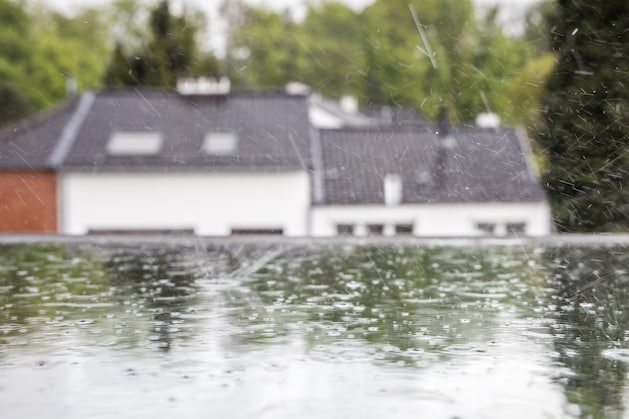Heavy rainfall is expected in Germany this weekend, and there is also a risk of flooding. Here you can find out what precautionary measures you can take to protect your home from possible damage caused by wet weather or storms.
Heavy rain and even the risk of flooding: Germany must prepare for severe weather next weekend.
Storms can pose a danger to property owners and homeowners. However, damage caused by thunderstorms, storms and wet weather can be minimized with most measures.
With just a few simple steps, major damage can be largely avoided. FOCUS online has compiled the best tips to help you protect your home from damage caused by storms, both immediately and preventively.
1. Close windows, roller shutters and blinds completely
Do not leave the shutters in the “half position” as the wind will otherwise penetrate between the half-closed shutters and the window and push the shutter out of its guide. Also, close all windows and doors if possible – including those in the basement.
2. Clear away loose items and secure loose items
During storms, loose objects flying around usually cause damage. Clear away even the smallest items. Also secure the garbage cans and, if necessary, move your car so that flying objects or branches cannot damage it.
Secure loose canopies, gutters, shutters, balcony railing cladding or awnings to prevent them from coming loose.
3. Remove old storm damage and clear control channels
Check your house for old storm damage – for example, loose roof tiles, shingles or cladding on dormers and gables – and secure them if necessary. If gutters are clogged with leaves, clear them, otherwise the rain threatens to overflow and damage the facade.
4. Remove important items from basements
In addition to personal items, you should also clear away dangerous substances and chemicals such as petrol and oil, pesticides and paints. If the latter get into the water, for example, the fire brigade will have to come.
5. Turn off the power
Turn off the power in rooms that are most likely to be flooded in heavy rain. In an emergency, you should also switch off the circuit breaker for the entire house. If there is a short circuit in the water, there is a risk of death.
6. Get sandbags, plastic sheets and boards to seal the house
Focus on doors and threshold-free windows on the ground floor, light shafts and windows as well as external stairs to basements.
7. Secure oil furnaces and heating tanks
They cause the highest amount of damage to cellars and can also pollute the environment through oil leaks.
You can take measures during construction to prevent long-term damage. However, some gadgets can also be installed later. The Flood Competence Center (HKC) has summarized the most important aspects in a graphic:
1. Backflow flaps
When there is heavy rain, the soil and sewer system usually have difficulty absorbing the large amounts of water. After the long dry period of the last few weeks, the soil is particularly hard and dry, which can lead to water seeping into the house through the drains.
A backflow flap closes the pipes from below and prevents water from the sewer system from entering the house due to backflow. Backflow flaps are particularly essential for buildings that are below the backflow level. The backflow level is usually at the level of the nearest manhole cover on the street. Backflow flaps can also be installed later on your home.
2. Dammbalkensysteme
Dam beam systems – usually made of aluminum – can effectively secure low-lying building openings such as courtyard entrances, cellars, house entrances or garages. Unlike sandbags, they can be used as often as you like and can hold higher water levels. There are now even systems that automatically set themselves up when they come into contact with water.
3. Other mobile protective elements
Window flaps, water barriers and raised edges on light shafts and cellar entrances protect your house from further moisture damage. Seal cellar rooms vertically and horizontally and install drainage.
4. “White tub”
Check pipe penetrations for water pressure: keyword “white tank”. This refers to water-impermeable structures made of concrete that are able to take on the load-bearing and sealing function. Additional sealing is not necessary.
5. Laubfanggitter
Install leaf guards in the gutter. These prevent leaves and needles from surrounding trees from collecting in the gutter and clogging it.
The consumer advice center has summarized further measures in an e-book.


